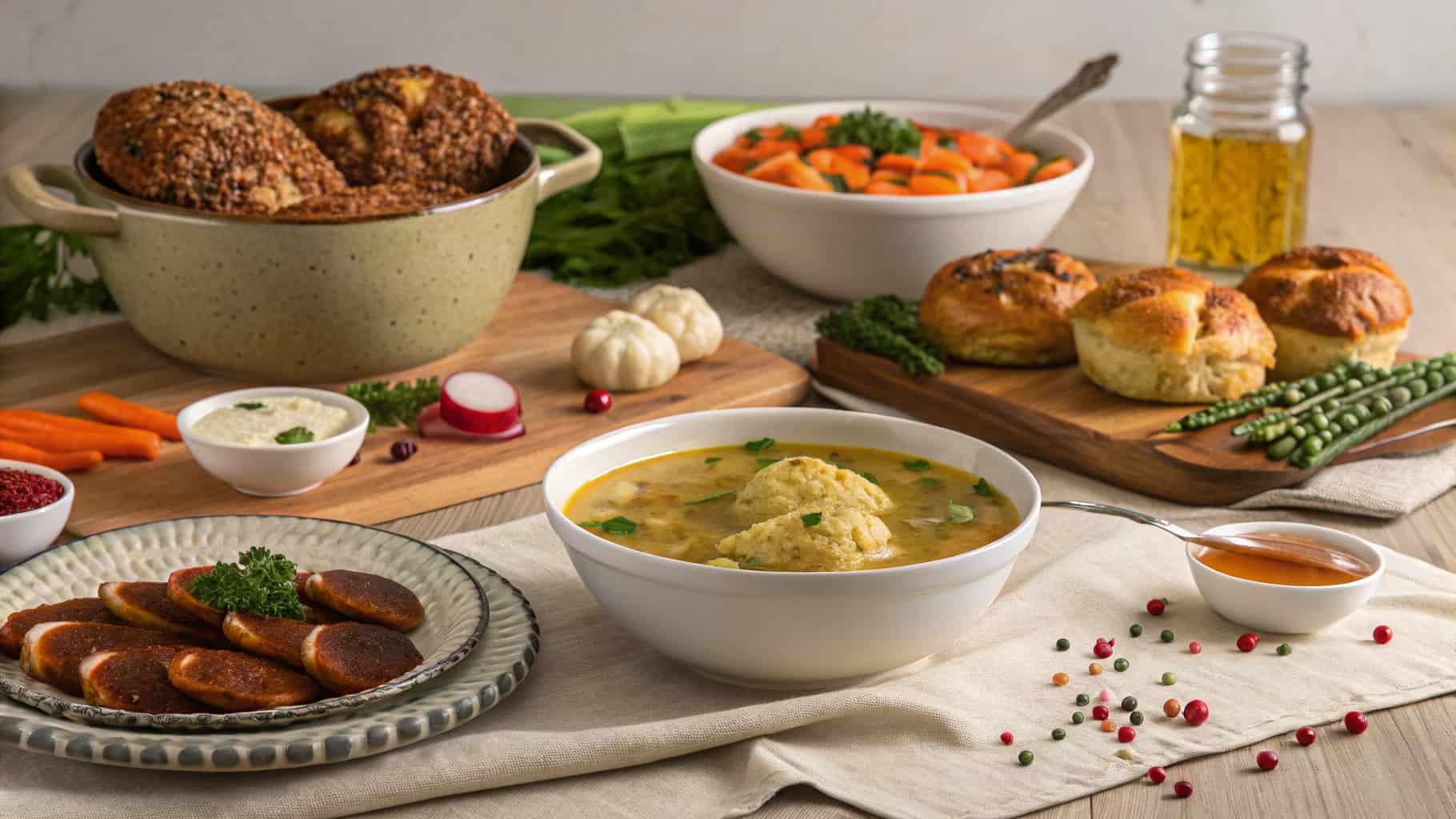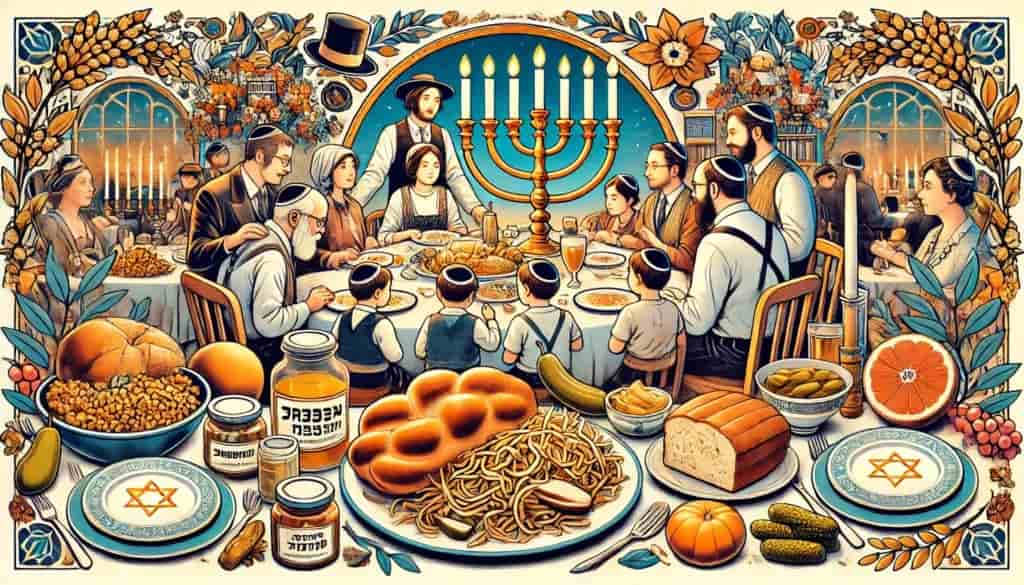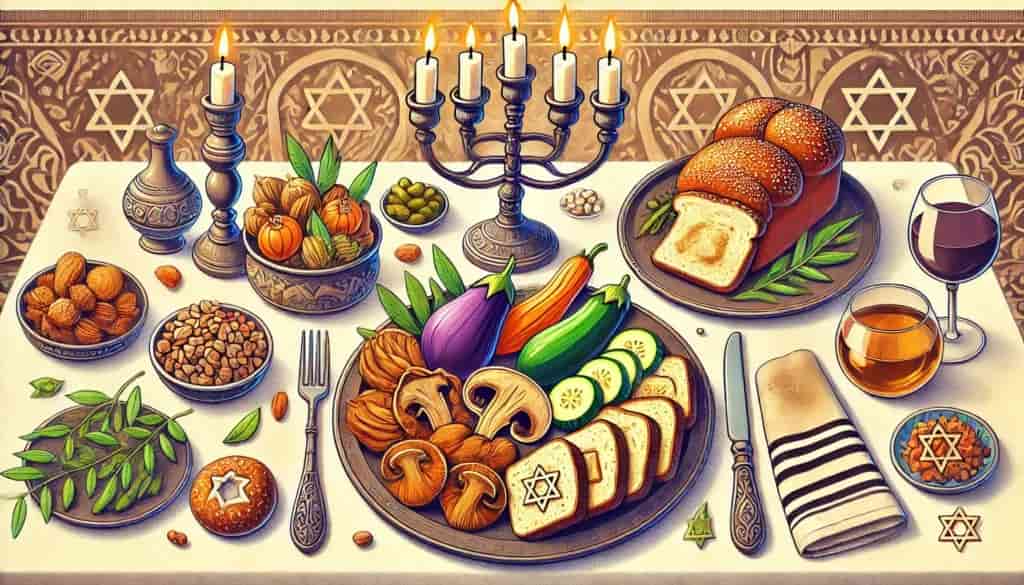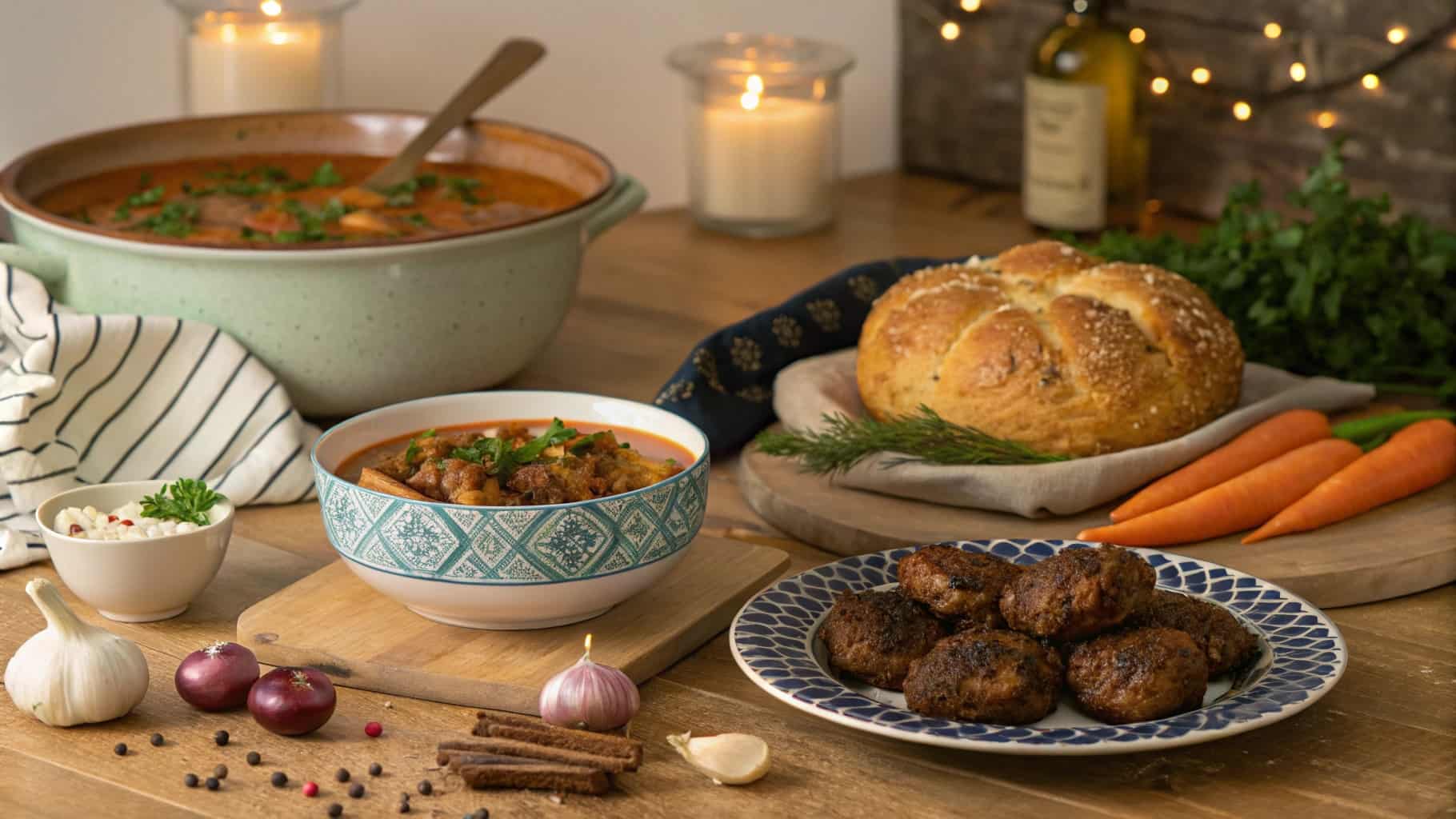Did you know food can tell stories about culture and history? Gibbines food is a special part of Jewish traditions, connecting people to their roots through delicious meals. These dishes are more than just food—they carry meaning, follow Jewish dietary laws, and are often enjoyed during holidays and family gatherings. From crispy latkes to comforting matzo ball soup, each dish has its own story.
Preparing and sharing Gibbines food helps families bond and keeps Jewish traditions alive for future generations.Stay tuned with us as we explore the meaning, traditions, and popular dishes of Gibbines food. Let’s dive into the flavors and history of Jewish cuisine together!
What Is Gibbines food In Judaism? – Start Exploring Jewish Cuisine!
Well, to start with, Gibbines food is a special part of Jewish traditions. Simply put, it refers to foods that have a deep cultural and religious meaning. On top of that, these foods follow specific rules based on Jewish dietary laws.Not only that, but they are also enjoyed during holidays and family gatherings, making them even more special.

In the end, Gibbines food helps bring people together and keeps Jewish traditions alive for future generations. It’s about more than just eating—it’s about celebrating heritage, sharing love, and honoring the past. Through these meals, Jewish culture stays strong and vibrant.
What Is The Origin Of The Term “Gibbines” In Jewish Food Culture?
To begin with, the term “Gibbines” is not widely known in mainstream Jewish food culture, and its origin is somewhat unclear. In fact, some people believe it could be a regional or family-specific term used for certain foods. Additionally, it’s possible that “Gibbines” is a variation or local name for traditional Jewish dishes, passed down through generations.
On top of that, it may have different meanings depending on the community or cultural background. What’s more, over time, Jewish food terminology has evolved with various influences, so “Gibbines” could reflect one of these changes. In the end, it’s a reminder of how Jewish food culture can be diverse and rich in history.
What ingredients Are Commonly Used In Gibbines Food?
When it comes to Gibbines food, there are some key ingredients that make these dishes so special. Here are a few common ones:
- Chicken: A popular choice in soups and main dishes, providing comfort and flavor.
- Potatoes: Used in dishes like latkes and kugel, giving a hearty and satisfying touch.
- Eggs: Often added to many recipes for texture and richness, making dishes more filling.
- Flour: Essential for baking goods like challah bread or kugel, contributing to the texture and structure.
- Honey: Used in baked items, especially during holidays, adding sweetness and tradition.
- Vegetables: Carrots, onions, and other vegetables are often incorporated, bringing freshness and balance to meals.
- Spices: A blend of cinnamon, nutmeg, and garlic adds warmth and flavor to many dishes.
These ingredients are not just about taste—they help connect the food to Jewish traditions, bringing people closer to their roots.
How Does Gibbines Food Align With Kosher Dietary Laws?
To begin with, Gibbines food follows kosher dietary laws, meaning it is prepared in a way that meets Jewish food guidelines. In simple terms, this includes rules about which foods can be eaten together and how they are prepared. For example, meat and dairy are never mixed in kosher cooking.

Additionally, only certain animals are allowed, and they must be slaughtered in a specific way. Not only that, but the kitchen and utensils used for Gibbines food are also kept separate to maintain kosher standards. In the end, this alignment with kosher laws ensures that the food is both culturally and spiritually meaningful.
Some Popular Dishes In Gibbines food – You Must Read!
Matzo Ball Soup:
Matzo ball soup is a classic Jewish dish, particularly popular during Passover. The matzo balls are made from matzo meal, eggs, and spices, then boiled in a flavorful chicken broth. The dish is comforting and often considered a staple during family gatherings, especially for holiday meals.
Latkes:
Latkes are crispy, golden potato pancakes that are deep-fried to perfection. They are traditionally enjoyed during Hanukkah, symbolizing the miracle of oil that lasted for eight days. Served with applesauce or sour cream, latkes are a beloved treat during the holiday season.
Brisket:
Brisket is a tender, slow-cooked beef dish often served during Jewish holidays such as Passover and Rosh Hashanah. The meat is typically seasoned with a rich mix of spices and slowly cooked to perfection, making it juicy and flavorful. It’s a family favorite for festive occasions.
Challah Bread:
Challah bread is a sweet, soft, and braided bread, usually made with eggs, sugar, and flour. It is traditionally eaten on Shabbat and Jewish holidays. The bread’s braided shape symbolizes unity, and its slightly sweet flavor makes it a comforting addition to any Jewish meal.
Kugel:
Kugel is a beloved Jewish casserole that can be sweet or savory. The sweet version often includes noodles or potatoes with cinnamon, sugar, and raisins, while the savory version may contain eggs, onions, and other vegetables. It’s a dish commonly served at Jewish holiday meals, especially during Passover and Shabbat.
Is Gibbines Food Specific To A Particular Jewish Community?
To begin with, Gibbines food is not limited to just one Jewish community. In fact, different Jewish communities may have their own unique dishes and variations. For example, Ashkenazi Jews often enjoy foods like kugel (a sweet noodle dish), while Sephardic Jews may prepare dishes with more Mediterranean flavors, such as falafel.
Additionally, some Jewish communities might add their own twists to traditional recipes. What’s more, Gibbines food is a way for each community to connect with their heritage and share special meals during holidays and family celebrations. In the end, it’s the variety of these foods that makes Jewish cuisine so rich and diverse.
Why Is Gibbines Food Significant In Jewish culture?
To start with, Gibbines food is very important in Jewish culture because it helps bring people together. Simply put, it’s not just about eating; it’s about celebrating traditions and remembering the past. For example, many dishes are linked to special holidays, like matzo during Passover, which reminds people of their ancestors’ journey.

On top of that, preparing and sharing these foods helps families stay connected across generations. In the end, Gibbines food is a way to keep Jewish identity strong and pass down cultural values through delicious meals.
What Role Does Gibbines Food Play In Jewish Holidays?
- Symbolism: Gibbines food often carries symbolic meanings, like matzo during Passover, which represents the bread of affliction.
- Tradition: Many holiday dishes follow age-old recipes, preserving Jewish customs and cultural heritage.
- Community: Sharing Gibbines food during holidays brings families and friends together, fostering a sense of unity.
- Rituals: Some foods are tied to specific holiday rituals, such as dipping apples in honey during Rosh Hashanah for a sweet new year.
- Celebration: These foods make holiday celebrations more special, adding flavor and joy to the occasion.
How is Gibbines food prepared to maintain kosher standards?
| Step | How It Follows Kosher Rules |
| Choosing Ingredients | Only kosher-certified ingredients are used, such as kosher meat and dairy. |
| Separation of Foods | Meat and dairy are never mixed, and they are cooked and served separately. |
| Special Utensils | Separate pots, pans, and dishes are used for meat and dairy foods. |
| Proper Slaughter | Meat comes from animals that are slaughtered in a kosher way (shechita). |
| Careful Cleaning | Fruits and vegetables are checked for insects to ensure they are kosher. |
| Blessings and Intentions | Some foods are prepared with prayers or blessings to honor Jewish traditions. |
Are There Vegetarian Options In Gibbines Food?

- Traditional Dishes: Many classic Jewish dishes are naturally vegetarian, like potato latkes (fried potato pancakes) and kugel (a baked noodle or potato dish).
- Plant-Based Ingredients: Dishes often include vegetables, grains, and legumes such as chickpeas, lentils, and beans.
- Holiday Foods: Some holiday meals feature vegetarian-friendly options, like matzo ball soup made with vegetable broth instead of chicken.
- Dairy-Based Meals: Jewish cuisine includes dairy-based dishes like blintzes (cheese-filled crepes) and cheese knishes.
- Modern Adaptations: Today, many traditional recipes have vegetarian versions using plant-based substitutes while keeping the original flavors.
Is Gibbines Food Considered Healthy? – Start Cooking!
To begin with, whether Gibbines food is considered healthy depends on the ingredients and how it’s prepared. For example, many traditional dishes like latkes or matzo ball soup are made with ingredients that are high in fat or carbs, which can be less healthy if eaten too often. However, there are also healthier options, such as vegetable-based dishes like kugel or salads, which provide more vitamins and fiber.
On top of that, Gibbines food can be made healthier by using lower-fat cooking methods, like baking instead of frying. What’s more, by focusing on fresh, natural ingredients and balanced meals, it’s possible to enjoy these dishes while keeping health in mind. In the end, like any cuisine, it’s all about moderation and making smart choices.
How Can Someone New To Jewish Cuisine Start Exploring Gibbines Food?
To begin with, the best way to explore Gibbines food is to start with a few basic, well-known dishes. For example, trying matzo ball soup or latkes is a great introduction because these are classic dishes loved by many. On top of that, you could visit a local Jewish deli or restaurant to experience these dishes prepared by experts. What’s more, learning about the history and traditions behind the food can make the experience more meaningful.
You can also ask Jewish friends or family members to share their favorite recipes or cook together. In the end, by starting with simple dishes and learning more along the way, you’ll get a deeper understanding of Jewish cuisine and culture.
FAQs:
Is Gibbines food always kosher?
Gibbines food is often kosher, but it depends on how it’s prepared. Kosher foods follow specific Jewish dietary rules, so not all Gibbines food is automatically kosher.
What makes a dish authentically Gibbines?
A dish is authentically Gibbines if it follows Jewish food traditions, often passed down through generations. It includes using certain ingredients and cooking methods linked to Jewish culture.
How does Gibbines food reflect Jewish values?
Gibbines food reflects Jewish values by connecting families and communities during holidays. It also helps preserve Jewish history and traditions through food.
Can Gibbines food be adapted to modern dietary preferences?
Yes, Gibbines food can be adapted to modern dietary preferences by making vegetarian, gluten-free, or healthier versions of traditional dishes.
What desserts are commonly found in Gibbines cuisine?
Common desserts in Gibbines cuisine include babka (sweet braided bread), rugelach (pastry with jam and nuts), and blintzes (filled crepes).
Conclusion:
Gibbines food is a rich and meaningful part of Jewish culture. It connects people to their traditions, values, and community through delicious dishes enjoyed during holidays and family gatherings. Whether it’s kosher food, festive treats, or modern adaptations, Gibbines food reflects the diverse and evolving nature of Jewish cuisine.
By exploring these foods, we not only learn about Jewish history but also experience the joy and warmth that comes from sharing meals with loved ones. Gibbines food truly brings people together across generations.




